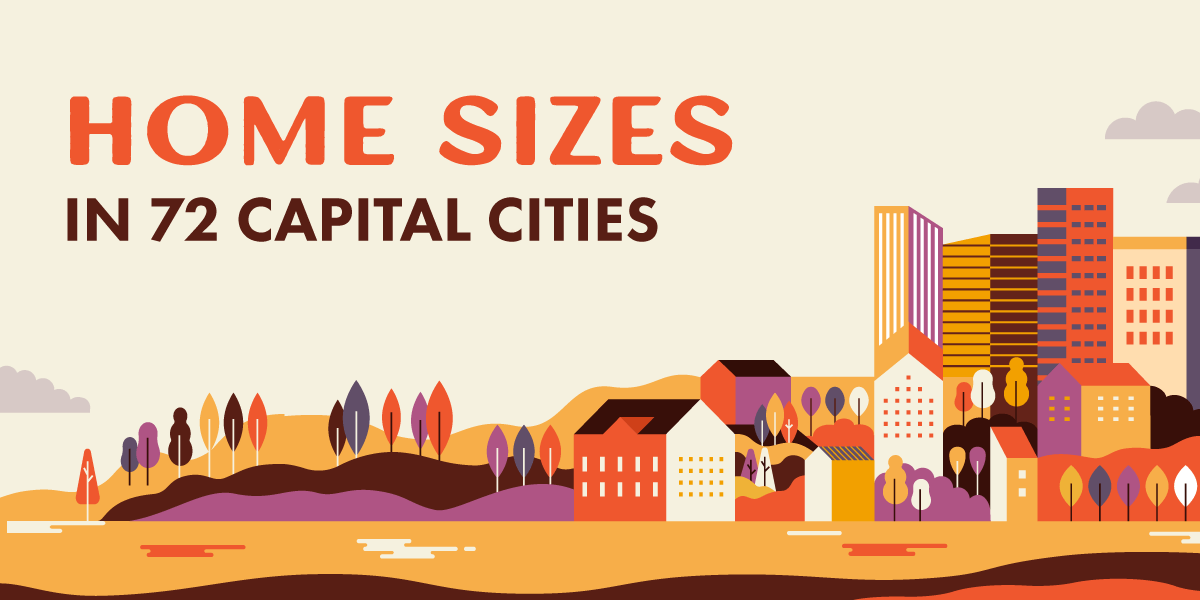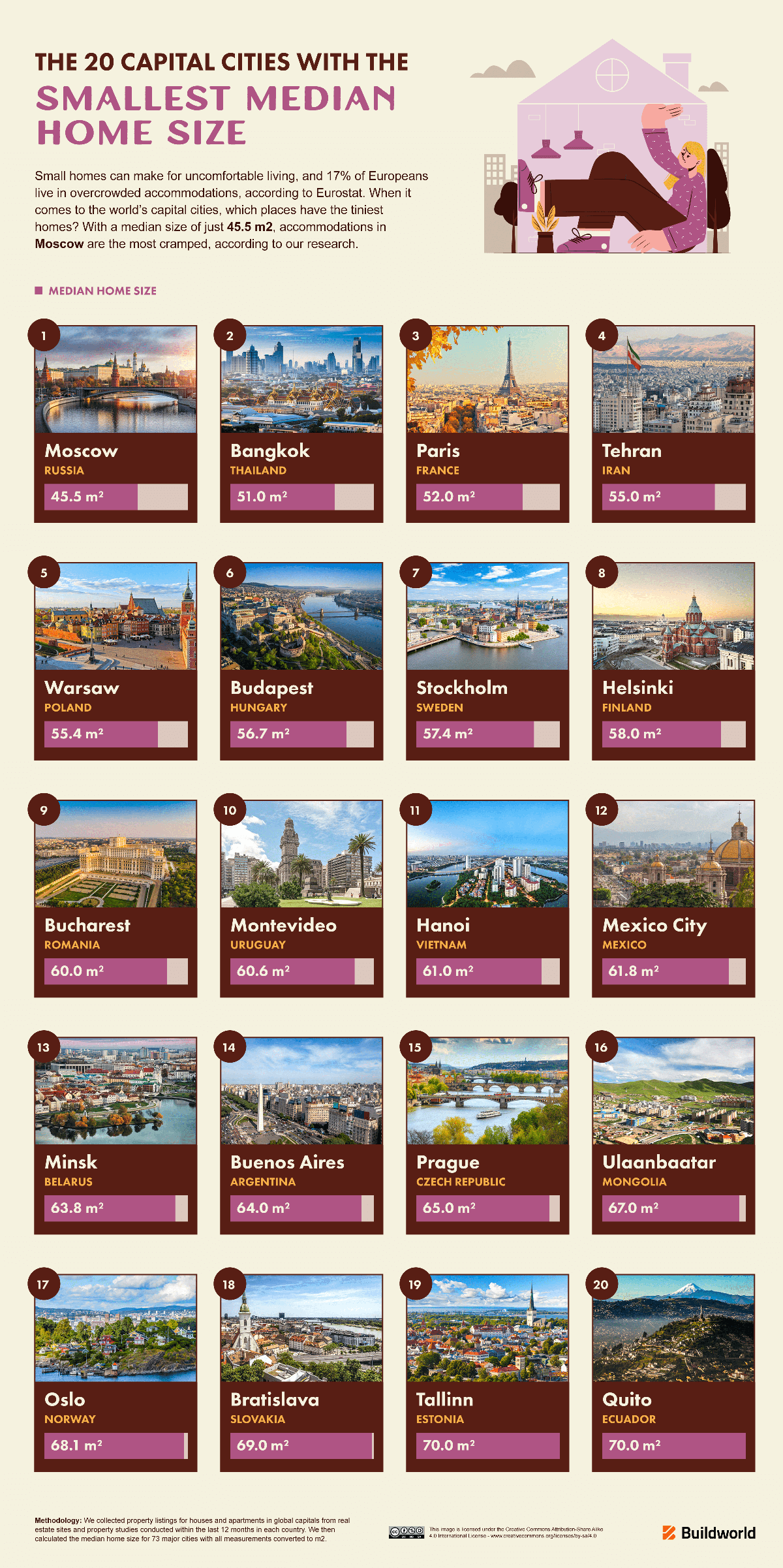
Your ability to swing a cat with minimal impact depends very much on the city in which you live.
The size of an average capital city home varies greatly around the world: for example, the average homeowner in Canberra has 560% more floor space than their counterpart in Moscow (256.3 sqm vs. 45.5 sqm).
And it's not just about having room to swing that cat. There are ongoing economic factors to think about as well. Smaller homes have been known to gain value more quickly (with the exception of so-called micro-homes under 37 sqm) - but larger homes are currently driving demand as workers continue to decamp to the home office. And while smaller homes tend to have a higher price tag per square metre, bigger ones cost more to heat and maintain.
Capital cities are the engine rooms of each country's economy and growth. But the folk who live there rarely get an even break – either with each other or with inhabitants of other capital cities. With the housing market in disarray and home improvement costs such as insulation on everyone's minds, Buildworld has identified the average capital city home size around the world - and created an interactive comparison tool so you can see how your capital measures up.
What We Did
Buildworld analyzed house and apartment listings in global capitals from the past year using real estate sites and property studies. We then calculated the median home size for 72 major cities and converted all measurements to square metres (sqm).
Key Findings
- Canberra in Australia is the world capital with the largest average home size, at 256.3 square metres.
- Brussels, Belgium, is the European capital with the largest average home (151.8 sqm).
- The Russian capital of Moscow has the smallest average home of any world capital (45.5 sqm).
49 Capital Cities Have Bigger Homes than London
On a countrywide scale, Australians and Americans have the highest average home size. But zoom in on the capital cities and it's a very different story. Australia stays top with its capital, Canberra, boasting an average 256.3 sqm home, but the average home in the U.S. capital of Washington D.C. is just one-third of this (86.6 sqm), ranking 35th out of the 72 capitals in our study.
London fares even worse, ranking 50th (75 sqm), while the Scottish and Irish capitals both rank in the top 25. You can use the interactive below to compare any two capital cities in our study.
European Capitals Have the World's Smallest Homes
Canberra's homes are larger than those in any other capital, or any other city in Australia. But it's not necessarily a good thing. Critics suggest building massive homes in Canberra is a trend that's out of control, with developers adding rooms for the sake of it and bumping up the carbon footprint along with the property footprint. Plus, "we're leaving vast members of the community behind," according to local architect Shannon Battison, "because not everyone can or should afford a huge house. And lots of us who can't afford these huge houses, but feel the need to build them because that's what everybody builds, are building them really badly."

Click here to see the image in full size
Of the top 20 cities, only Brussels, Edinburgh, and Nicosia are in Europe. The European Commission explains that "some of Europe's capital cities are economically dominant," with residents flocking in "to benefit from the education, jobs, lifestyles and cultural life that they offer". This pushes up prices as well as adding pressure to the finite space, particularly given the urban trend of living alone (some 50% of homes in Oslo, Berlin, and Paris have single occupiers.)

Click here to see the image in full size
Meanwhile, 12 of the capitals with the smallest homes are in Europe, as the above chart shows. Moscow's homes are the smallest, although this is less to do with spatial pressure and more about culture and politics. Much of the Russian capital's 20th-century housing stock consists of Soviet-era multi-storey apartment buildings designed to accommodate the needy at minimum cost. Today, living in an apartment block is the 'norm', and it is prohibitively expensive and complex to upscale to a larger private house.
Brussels is the European Capital with the Largest Homes
Although European capitals tend towards having smaller homes compared to other regions, there is a large disparity within Europe itself. The disparity cannot be attributed purely to economic factors: number two on the list, Luxembourg, has the highest GDP/capita on the continent, while Brussels, with the biggest homes, is the capital of the 11th richest country, Belgium. Portugal and Croatia both have around half the GDP of Belgium, but the average home in either of their capitals is on the roomy side of 100 sqm.

Click here to see the image in full size
Stockholm and Paris sit alongside Moscow and the capitals of several former Soviet Bloc countries at the smaller end of the table. The popularity and importance of Paris are hugely disproportionate in comparison to other French cities, and space is at a premium. French law stipulates that a home need only be a minimum of nine sqm, but thousands of tiny Chambres de Bonne (former maids' rooms) and curiosities (like this one-sqm 'baby's house') drag down the average.
Species of Spaces
A capital city has a special buzz and is often the hub of a nation's economy, art, and social life. Young students and graduates flock to the capitals with high ambitions and the desire to be where 'it all happens'. But the online decentralization of information and the recent boost to the WFH movement have left professionals and families alike thinking about finding more space for less money. You can check through all our data in the interactive below to identify the capital cities that at least continue to offer more space on average.
Of course, the choice about which area you live in or the size of home for which you're willing to sacrifice other benefits is not always so freely made. But as the chicest of small-homed Parisians show us, home is where you make it - and with effort and imagination (and a little elbow grease), a small city home needn't feel undersized at all.
No matter the size of your home, we have you covered at Buildworld. Our range of internal doors, external doors and Internal Glazed Doors are suitable for bigger areas. Most of these doors can also be trimmed on their edges to fit in smaller dimensions, making them perfect for all kinds of spaces. Available at reasonable prices, you can renovate your home without denting your pocket.
METHODOLOGY & SOURCES
This dataset was compiled using two methods: our own country-by-country analysis of property listings and manual research to find property studies conducted within the last 12 months from local real estate companies in each country.
We collected property listings for houses and apartments in 72 capital cities worldwide from various sources [1] and converted the floor areas to square metres. We then calculated the median home (houses and apartments) size for each city in the dataset.
To supplement this data, we manually researched property studies conducted in each country in 2022 to cross-reference against our own data and to add additional capital cities where their property websites lacked specific data points.
The data was collected in October 2022.
[1] Example Sources:
- Spain: Idealista.com
- Singapore: 99.co
- Scotland: Rightmove.co.uk
- United States: Zillow.com
- China: est.fang.com
Related Articles
Category
Doors & WindowsPosted On
25th December 2024



